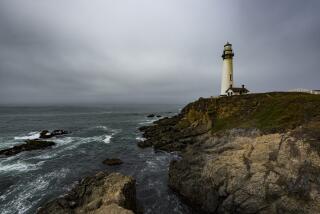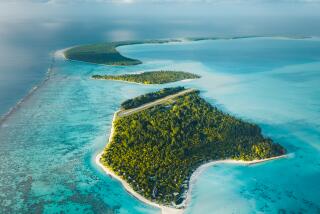Vanuatu islands: Get happy, get a little wild
- Share via
Reporting from Yakel Village, Vanuatu — — My teenage daughter is standing in a lineup of tribesmen and she is angry with me. As I lift my camera, she says, “I look hideous,” unaware of the irony of being surrounded by tribesmen wearing next to nothing.
“Yu, pikinini blong Amerika (You, child belonging to America),” the chief says, introducing Indigo to his grandson, who looks to be a much happier teenager. “Yu gat hamas yia? Yu slip wea? (You’ve got how many years? Where are you staying?)”
We are in the Yakel Village on the South Pacific island chain of Vanuatu. To be specific, we are on the southern island of Tanna, and the Yakel, who live as they have for 4,000 years, have eschewed Western clothing and most white-man trappings. They speak only their tribal language and Bislama, the pidgin English that unifies the Ni-Vanuatu (Vanuatu people).
I grew up in the South Pacific. Back then, Vanuatu was called the New Hebrides and was one of the poorest nations in the region, with little to recommend it to tourists. Within the last five years, however, it has become a hot spot for adventure travelers and now boasts several swanky resorts. In 2006 it was voted the happiest place on Earth by the think tank Happy Planet Index. (The U.S. ranked 150th.)
The reason they’re happy is not that the Ni-Vanuatu have the most stuff; by U.S. standards Vanuatu is poor. (Subsistence agriculture does not count as wealth on the economic index.) But Vanuatu has idyllic white-sand islands, clear waters, waterfalls, great diving, the world’s most accessible live volcano and food that grows faster than it can be picked.
The people don’t big-foot on their environment, there’s no litter, not much waste, little obesity. They share almost everything and, most important, there’s no cultural yearning to keep up with the Joneses. I decided this concept would be good for my family, and so my husband, Greg; daughters, Indigo and Sofia; and I spent 10 days here last July.
Vanuatu is a string of 83 Melanesian islands surrounded on three sides by the Solomon Islands, Fiji and New Caledonia. The islands have a total population of 240,000. We visited three: Éfaté, home of Port-Vila, the capital; Tanna, home to the volcano and the nearly naked men; and Espiritu Santo, where a billionaire’s private island resort recently opened.
After several hours with the Yakel, we said “tata” (goodbye) to the tribesmen, and our driver (driving yourself is not recommended because of bad roads) moved on to Mt. Yasur, one of the most spectacularly active volcanoes in the world. If you’ve ever fancied getting close to a volcano, here’s your chance. The bone-rattling two-hour road trip to get there is less spectacular.
We pulled up before sunset, watching as gray clouds, as tall as multistoried buildings, mushroomed from the crater. We climbed its flank and approached the rim. It struck me as odd that there were no railings, no warning signs, no ropes and no rangers keeping visitors away from the edge. A part of happiness, I figured, must be managing one’s own fate.
As darkness fell, we could see the gray, ashy plumes turning brilliant scarlet, red and purple, shooting fireball rocks wildly into the night sky. We were transfixed. We had expected to spend two hours there and we spent five, trying, in vain, to capture the exhilaration on film.
I later learned that in recent years three people were killed by flying lava after climbing too low into the crater. Self-determination can be dangerous.
Accommodations on Tanna were basic. White Grass Ocean Resort is as good as it gets and is pleasant and fun, although the rooms are Spartan and small. You don’t go to Tanna for luxe digs; our three days there were sufficiently stimulating.
The words “private island” typically mean “out of my reach,” but Ratua, a private island off Espiritu Santo, seemed reasonable to me for all that’s included. The $430 per person per night (children are half-price) includes the 45-minute transfer to the island, a private villa, all meals, Internet, horseback riding, windsurfing, mountain bikes, snorkel gear and canoes.
In 2004, a French businessman cashed out, bought a yacht and he, his wife and two small children sailed the world looking for their dream island. They spent more than a year looking, eventually wandering into the friendly waters around the large northern island of Espiritu Santo.
There they discovered Ratua, a 146-acre coconut plantation surrounded by turquoise water, tropical fish, powdery white sand and abundant plant life. The owner, who prefers to remain unidentified but who happened to be here when we were, had found his Nirvana. While we rode horses with our kids, I asked him about choosing such a remote place. “We were seduced by the island, but mainly we loved the people,” he replied. What he didn’t tell me is that all of the resort’s profit is donated to local communities, funding the area’s first hospital and supporting educational improvements.
The resort was built to be eco-friendly, which entailed repurposing 200-year-old teak houses from Sumatra and having them reconfigured in Bali and erected as 10 rustic-luxe villas on Ratua. Everything is hand-carved, ancient and sumptuously decorated. There are no hair dryers, phones, TVs or coffee machines in the villas. Instead, you have to wander down to the bar to get your espresso and Internet. The restaurant has a culturally shell-shocked chef from New York who serves the freshest fish and lobster (which teem like pests in the waters off Ratua) I have ever tasted.
A trainer who used to ride with the Lipizzaner was in charge of the 20 horses available for guests, and one day we swam a channel with the horses and headed through verdant jungle on a neighboring island. It was world-class riding.
Indigo and I decided to visit the mainland of Espiritu Santo to explore the Millennium Cave, which, as evidence of Vanuatu’s remoteness, was first explored in 2000. We left behind Greg and Sofia because the trip was labeled unsuitable for kids under 10. I rarely pay attention to things labeled “tough” because it’s often an overstatement, but “tough” in Vanuatu really means, “Holy smokes, what have I done?” After a jarring one-hour drive, a 45-minute walk through a steamy bamboo forest, a stop at a village long house for a cup of instant coffee and an incomprehensible briefing from our village guide, we were off.
There was a one-hour trek through knotted jungle and several steep descents on ladders fashioned from branches lashed together with palm fronds before we finally descended into the cave, which stretched, pitch-dark, for two miles. For more than 90 minutes we traversed rocky ledges, waded chest-high in the river that rushed through the cave, crawled over slick boulders and squeezed through narrow cracks, all clutching waterproof flashlights. Any pride I had about my fitness was dashed, and I emerged with my legs shaking. Indigo, a sprightly 13, was grinning madly and claiming she wasn’t tired at all.
But wait. There was more.
After a sit-down and a sandwich, we were handed a child’s blow-up swim ring and told to get in the river. The only way out was to swim down a canyon, get out, portage your body around rocks, swim under waterfalls, get out again, climb a cliff and then traipse back through the jungle. I had never been more exhausted, but it was a true-blue adventure and I would do it again in a heartbeat.
As we made the after-dark return to Ratua, the driver amused us by teaching us Bislama. My favorites: Helicopter: Mixmaster blong Jesus Christ. Sea gull: pigeon blong solwater; a gossip: bigmaot; and bra: basket blong titi.
Back at Ratua, guests were invited to go outside on a deck cantilevered above the lagoon. Below us, a group of women in grass skirts waded into the sea up to their waists. They began to sing and rhythmically beat the ocean with their hands, performing the water music of nearby Banks Island. An ancient ritual performed only by women, this performance seemed to prove that humans will always find a way to make music. Later that night, warriors, also from Banks Island, covered in body paint and wearing coconuts on their heads, rushed into the bar, where they performed athletic and fearsome dances, sending us off with an indelible memory.
Our final night was spent at Eratap, an Australian-owned beach resort 20 minutes from busy and unattractive Port-Vila on the main island of Éfaté. The resort has 12 large seaside villas, a shimmering beach, a huge pool and a relaxed surfer attitude. There are other resorts on Éfaté, but many don’t allow children.
Vanuatu had become one of my favorite places. In a world where most places are thoroughly explored and exploited, it felt untouched, blessed with abundant nature and kind people. Every day had brought us a new experience.
More to Read
Sign up for The Wild
We’ll help you find the best places to hike, bike and run, as well as the perfect silent spots for meditation and yoga.
You may occasionally receive promotional content from the Los Angeles Times.






